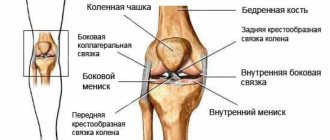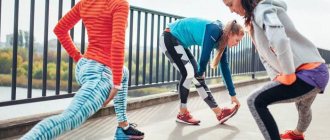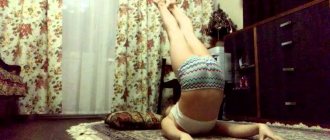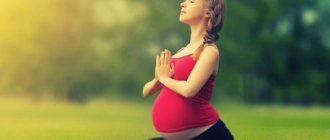Main working muscles[edit | edit code]
Back extensor muscles
: erector spinae muscle (spinalis, longissimus and iliocostal muscles), semispinalis muscle, group of deep spinal muscles.
Accessory muscles[edit | edit code]
Abdominal muscles that stabilize the spine
: transverse abdominis, internal oblique, external oblique, rectus abdominis.
Muscles that extend the leg at the hip joint
: gluteus maximus, posterior thigh muscle group.
Adductor muscles of the arm
: latissimus dorsi, pectoralis major.
Muscles that extend the arm at the elbow joint
: triceps.
Recommendations for execution technique[edit | edit code]
- In the 2nd phase of back extensions, lying on your stomach, provide support for the spine by tensing the abdominal muscles and do not lift your legs off the mat, lifting your torso with the force of the erector spinae muscles.
- Raising the body should occur gradually, vertebra by vertebra, starting from the cervical region. Pay special attention to the work of the muscles that extend the spine in the thoracic and lumbar regions. The head should be in line with the body.
- Press your arms firmly to your sides using your adductor muscles, particularly the latissimus dorsi and pectoralis major. Both of these muscles also help lower the shoulder blades. To achieve this, point your fingers toward your feet and fully straighten your elbows. Activating the latissimus dorsi muscle is essential as it plays a key role in torso stabilization.
- In phase 3 of the prone back extension, the spinal erector muscles work eccentrically to control the lowering of the torso. This process also occurs gradually, from the lower parts of the spine to the upper ones. The abdominal muscles provide support to the spine at this time.
- Mental image. To properly straighten your entire body, imagine that rubber bands are tied to your legs and the crown of your head, stretching you in different directions.
Various performance techniques
Let's look at three options for lying leg raises, designed for people with different levels of physical fitness:
- People with weak abdominals who want to strengthen them.
- Physically trained people who want to make their abs stronger and more prominent.
- Athletes who require increased exercise.
For each category we present one version of the exercise.
Also, this version of the exercise is indicated for osteochondrosis or recovery after abdominal surgery.
- Starting position – lying on your back, lower back pressed to the floor. The arms are extended along the body or clasped behind the head.
- Beginners can raise their heads. Feet together. Raise one leg to an angle of 45–60 degrees, hold it for 1–2 seconds and lower it to the starting position.
- When the heel of the first leg touches the floor, you can lift the second leg.
- Repeat the same for the second leg.
For beginners, it is recommended to do this exercise every day, 1-2 sets of 10 times for each leg.
Watch your breathing. Exhale at maximum load. That is, we raise our legs - exhale, lower them - inhale.
To recover after surgery, it is recommended to further bend the leg at the knee so that there is no discomfort at the incision site. Gradually straighten your leg until it straightens. Attention! After the operation, you must wait the minimum time specified by the doctor, after which you can do any physical activity!
During pregnancy, it is better to cancel this exercise. Women should put less stress on their abs than men. Overdeveloped muscles can make childbirth difficult.
This exercise option is suitable for healthy people with an average level of physical fitness.
- Starting position: as in the previous case. That is, lying on your back, on the floor. Raising your head is not recommended, as this makes the exercise easier. Feet together.
- We begin raising both legs to an angle of 45–60 degrees, pause for 1–2 seconds while raised and lower them back.
There are two variations of this exercise technique:
- Lowering your heels to the floor. This is easier to do, because when you touch the floor, your abs rest.
- Without lowering your heels onto a horizontal surface, leaving 1-2 cm to it. This is the most effective version of the exercise, which keeps your abs tense all the time.
It is recommended to perform 2-3 sets, starting with 10-12 repetitions. For yourself, you can reach 30 repetitions in each approach. You should start with the first option, when your feet fall to the floor. After 1–2 weeks, you can move on to the second option, when the heels do not touch the floor.
If desired, the legs can be held in the raised position for more than two seconds (depending on how you feel).
If your abdominal muscles are well developed and you need to increase the load, this option is perfect.
The technique is the same as in the previous exercise. The nuance is this: a weighting agent is attached to each leg (standard on the mounts). Alternatively, you can hold a dumbbell with your feet. The weight of the dumbbell is selected individually.
Raise your legs to an angle of more than 60 degrees or less than 45. The meaning of the exercise is lost. When the legs are raised higher, the muscles relax. Below – the muscles do not reach peak tension.
Notes[edit | edit code]
The purpose of the prone back extension is to strengthen the back extension muscles, particularly the erector spinae, and to develop the ability to simultaneously engage the abdominal muscles to protect the lower back from injury.
The abdominal muscles should provide support to the spine as it extends. Since the lumbar spine is curved forward, and the thoracic spine, on the contrary, backward, when performing this and similar exercises, there is a tendency for excessive arching in the lower back. In this case, the pelvis usually tilts forward. By tightening your abdominal muscles and pulling them up, you tilt your pelvis back. Press your pubic bone firmly into the mat, draw your stomach in, and direct the force of your abdominal muscles toward your chest. This will prevent the pelvis from tilting forward and will relieve unnecessary tension from the lumbar region. Stabilizing the lumbar spine allows you to focus on the muscles in the upper torso, which play an important role in creating good posture and correcting slouching. The hip extensor muscles also help stabilize the pelvis and prevent it from tilting forward, forming a force pair with the abdominal muscles. The ability to use the abdominal muscles to stabilize the lumbar region is basic. It is necessary to optimally perform more complex back extension exercises, such as the Swim and Double Kick.
Set of physical exercises No. 4 in the starting position lying down
Republican Scientific and Practical Center for Radiation Medicine and Human Ecology
Department of physiotherapy and medical rehabilitation
Complex of physical exercises No. 4
in the starting position lying down
| № | Original position | Description exercises | Number of repetitions | Methodical instructions |
| Preparatory part (7-8 minutes) | ||||
| 1. | Lying on your back, legs straight, foot-width apart, arms to the sides, palms down. | Alternately bend and straighten your legs at the knees, sliding your heels along the floor. | 4-6 times with each leg | The pace is average. Breathing is voluntary. |
| 2. | Lying on your back, feet shoulder-width apart, knees bent, arms to the sides, palms down. | Lower your knees to the right and your head to the left, trying to put your knees on the floor - inhale, then lower your knees to the left and your head to the right - exhale. | 4-6 times in each direction | The pace is average. Breathing is voluntary. |
| 3. | Lying on your back, legs wider than shoulder-width apart, knees bent, arms to the sides, palms down. | Bring your knees together - inhale, return to i. p. - exhale. | 8-10 times | The pace is average. Breathing is voluntary. |
| 4. | Lying on your back, legs together, knees bent, arms to the sides, palms down. | Spread your knees to the sides - inhale, return to i. p. - exhale. | 8-10 times | The pace is average. Breathing is voluntary. |
| 5. | Lying on your back, feet shoulder-width apart, knees bent, arms to the sides, palms down. | Pull your knees to your chest - inhale, return to i. p. - exhale. | 8-10 times | The pace is average. Breathing is voluntary. |
| 6. | Same. | Pull your knees to your chest and lower to the right, and your head to the left - inhale, return to i. p. - exhale. The same thing - lower your knees to the left and your head to the right. | 4-6 times in each direction | The pace is average. Breathing is voluntary. |
| 7. | Lying on your back, legs straight, foot-width apart, hands to your shoulders. | Spread your arms to the sides - inhale, return to i. p. - exhale. | 8-10 times | The pace is fast. Breathing is voluntary. Do not bend your elbows. |
| 8. | Same. | Raise your hands up - inhale, return to i. p. - exhale. | 8-10 times | The pace is fast. Breathing is voluntary. Do not bend your elbows. |
| 9. | Lying on your back, legs straight, feet width apart, arms raised up. | Crossed movements of arms to the sides. | 8-10 times | The pace is fast. Breathing is voluntary. Do not bend your elbows. |
| 10. | Same. | Crossed movements of the arms forward and backward. | 8-10 times | The pace is fast. Breathing is voluntary. Do not bend your elbows. |
| Main part (15-17 minutes) | ||||
| 11. | Lying on your back, the heel of your right foot is placed on the toes of your left foot, arms to the sides, palms down. | Lower your feet to the right and your head to the left, trying to place your feet on the floor, then lower your feet to the left and your head to the right. | 4-6 times in each direction | The pace is average. Breathing is voluntary. |
| 12. | Lying on your back, the heel of your left foot is placed on the toes of your right foot, arms to the sides, palms down. | Lower your feet to the left and your head to the right, trying to place your feet on the floor, then lower your feet to the right and your head to the left. | 4-6 times in each direction | The pace is average. Breathing is voluntary. |
| 13. | Lying on your back, feet shoulder-width apart, knees bent, arms to the sides, palms down. | Raise your pelvis up - inhale, lower your pelvis down - exhale. | 8-10 times | The pace is average. Breathing is voluntary. |
| 14. | Same. | Raise your pelvis and straight right leg up - inhale, return to i. p. - exhale. The same thing - raise your pelvis and straighten your left leg. | 8-10 times | The pace is average. Breathing is voluntary. |
| 15. | Lying on your back, legs straight, foot-width apart, arms to the sides, palms down. | Raise your legs without bending your knees to a vertical position - inhale, return to i. p. - exhale. | 8-10 times | The pace is average. Breathing is voluntary. |
| 16. | Lying on your back, legs straight, foot-width apart, arms along the body, palms down. | Circular rotations with your arms inward. | 8-10 times | The pace is fast. Breathing is voluntary. Do not bend your elbows. |
| 17. | Same. | Circular rotation with arms outward. | 8-10 times | The pace is fast. Breathing is voluntary. Do not bend your elbows. |
| 18. | Lying on your right side, legs straight, left leg on top of your right, right hand under your head, left hand on the floor in front of your chest. | On “one” - bend your left leg at the knee, on “two” - return to i. p., on “three” - raise the straight left leg up, on “four” - return to i. P. | 8-10 times | The pace is average. Breathing is voluntary. |
| № | Original position | Description exercises | Number of repetitions | Methodical instructions |
| 19. | Lying on your left side, legs straight, right leg resting on your left, left hand under your head, right hand on the floor in front of your chest. | On “one” - bend your right leg at the knee, on “two” - return to i. p., on “three” - raise the straight right leg up, on “four” - return to i. P. | 8-10 times | The pace is average. Breathing is voluntary. |
| 20. | Lying on your stomach, legs straight, shoulder-width apart, arms bent at the elbows, at chest level. | Straighten your arms at the elbows, bend over - inhale, return to i. p. - exhale. | 8-10 times | The pace is average. Breathing is voluntary. |
| 21. | Lying on your stomach, legs straight, foot-width apart, arms bent in the shape of a diamond and lying under the forehead. | Pull your right knee to your chest - inhale, return to i. p. - exhale. The same thing - tighten your left knee. | 4-6 times with each leg | The pace is average. Breathing is voluntary. |
| 22. | Lying on your stomach, legs straight, shoulder-width apart, arms extended forward, palms down. | Raise your right hand to the side - up - inhale, return to i. p. - exhale. The same with the left hand. | 4-6 times with each hand | The pace is average. Breathing is voluntary. Do not bend your elbows. |
| 23. | Same. | Raise your right leg up - inhale, return to i. p. - exhale. The same with the left foot. | 4-6 times each foot | The pace is average. Breathing is voluntary. Do not bend your knees. |
| 24. | Same. | Raise your right arm to the side - up and your left leg up - inhale, return to i. p. - exhale. The same with the left hand and right foot. | 8-10 times | The pace is average. Breathing is voluntary. Do not bend your elbows. Do not bend your knees. |
| 25. | Lying on your stomach, palms at chest level, legs straight, shoulder-width apart. | Without raising your head, lifting your pelvis, move to the knee-elbow position - exhale, return to i. n. - inhale. | 4-6 times | The pace is slow. Breathing is voluntary. |
| Final part (3-5 minutes) | ||||
| 26. | Lying on your back, legs straight, shoulder width apart, arms to the sides, palms down. | Alternate flexion and extension of the feet at the ankle joints. | 4-6 times with each foot | The pace is average. Breathing is voluntary. Do not bend your knees. |
| 27. | Same. | Circular rotation of the feet outward and inward. | 4-6 times in each direction | The pace is average. Breathing is voluntary. Do not bend your knees. |
| 28. | Same. | Bring your feet together and spread your feet outward. | 4-6 times in each direction | The pace is average. Breathing is voluntary. Do not bend your knees. |
| 29. | Same. | Pull your feet towards and away from you. | 4-6 times in each direction | The pace is average. Breathing is voluntary. Do not bend your knees. |
| 30. | Lying on your back, legs straight, foot-width apart, arms up, hands clenched into a “lock” and turned outward. | Roll onto your stomach to the left - exhale, return to i. n. - inhale. The same - to the right. | 4-6 times in each direction | The pace is slow. Breathing is voluntary. |
Note:
The lesson is carried out in a well-ventilated area, no earlier than 1 hour after eating. The duration of the lesson is 25-30 minutes. Class density is 75-80%. After performing physical exercises, it is advisable to take water, air and hardening procedures.











